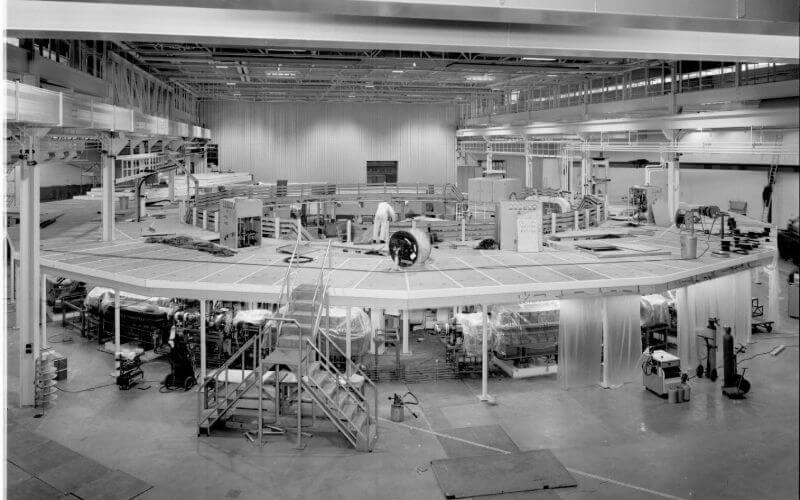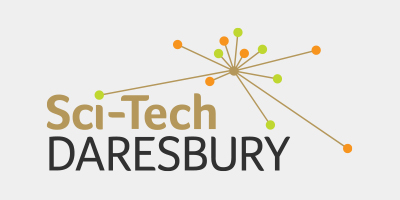November 6, 2020
40 years of impact from a world-first facility at Daresbury
STFC's Daresbury Laboratory is celebrating 40 years of world-changing impact

STFC's Daresbury Laboratory is celebrating 40 years of world-changing impact thanks to research carried out at its Synchrotron Radiation Source facility (SRS), one of the world’s most pioneering scientific inventions of its time. Throughout its 28 years of operation until 2008, and two million hours of science, the SRS created, and continues to have, many significant and positive impacts across many aspects of our daily lives - from more effective cancer treatments, to cleaner fuel and new medicines.
Synchrotron research facilities can accelerate electrons to near light speeds so that they give off light that is billions of times brighter than the sun. The bright beams are directed into laboratories where scientists can use the light to study a diverse range of subject matter. These can be anything from fossils to jet engines, and viruses to vaccines. The SRS produced beams of light so intense that they revealed the structure of atoms and molecules inside materials.
Worldwide impact and two Nobel Prizes
The first of its kind, the SRS enabled research that has improved the quality of our lives in so many ways. This included research into diseases such as HIV and AIDS, as well as motor neurone disease, to name just a few examples. The structure of the Foot & Mouth virus was solved for the first time at the SRS - it was the first animal virus structure to be determined in Europe and led to the development of a vaccine. The huge magnetic memory of the Apple iPod was also the result of research carried out on the SRS. However, its most famous achievement was the key role it played towards a share of two Nobel Prizes in Chemistry. One to Sir John Walker in 1997, for solving a structure of an enzyme that opened the way for new insights into metabolic diseases, and the other to Sir Venki Ramakrishnan in 2009, for his work on the structure and function of the Ribosome, the particle responsible for protein synthesis in living cells.
During its lifetime, the SRS created a critical mass of highly skilled engineers and technicians at Daresbury Laboratory, with specialisms ranging from detectors to magnets and electronics, and by the time it closed in 2008, it had collaborated with almost every country active in scientific research. It had hosted over 11,000 users from academia, government laboratories and industry worldwide, leading to the publication of more than 5000 research papers, resulting in numerous patents. The economic impact of this was vast on a worldwide scale, but it also played an important role in boosting the regional economy of the North West, having worked with hundreds of local businesses.
The success of the SRS led to the development of many similar machines around the world, with the technologies and skills developed still in use at many facilities today, including its UK successor, the Diamond Light Source at Harwell Science and Innovation Campus in Oxfordshire. It also led to the establishment of ASTeC, a leading centre for accelerator science and technology at Daresbury Laboratory, and the Cockcroft Institute, a joint venture between STFC and the Universities of Lancaster, Liverpool, Manchester and Strathclyde. It is also home to CLARA, a unique particle accelerator designed to develop, test and advance accelerator technologies of the future. Research carried out by accelerator scientists at Daresbury has had many impacts, particularly in the health and medicine arena, including work to develop our next generation of proton imaging technology for cancer detection, and research that could one day lead to more efficient diagnoses of cervical, oesophageal, and prostate cancers. In the footsteps of senior scientist, Professor Ian Munro, who was responsible for the plan to build the SRS and for its operation at Daresbury, ASTeC's accelerator scientists and engineers continue to play a key role in designing, building and upgrading the world’s newest generations of accelerator facilities.
At the leading edge of emerging technologies
The cutting-edge science and experimental results emerging from the early days of the SRS also led to the establishment of the internationally recognised Scientific Computing Department at Daresbury, and subsequently to the opening of the Hartree Centre in 2012. Today, the Scientific Computing Department continues to support UK science facilities and academia with computational and data-intensive research, and the Hartree Centre is a high performance computing, data analytics and artificial intelligence research centre. It enables UK businesses, from large corporates to start-ups and small businesses, to benefit from the specialist expertise and access to supercomputers that would normally only be available to academic researchers. Since its formation, the Hartree Centre has become a cornerstone of the UK tech industry - developing innovative products, delivering huge social benefits and boosting international competitiveness for UK businesses.
Professor Susan Smith, Head of STFC's Daresbury Laboratory said: "It is with immense pride that I look back and contemplate the success of the SRS, and how it enabled the ground breaking research that changed the world we live in for the better. Its economic and social impact has been vast and has continued to positively impact our world years after its closure. Here at STFC's Daresbury Laboratory we have always been committed to supporting excellent research and providing access to world-class research facilities and expertise to solve real world challenges. Daresbury Laboratory continues to be, even more than ever, an exciting international hub for skills and excellence in science and technology that, as part of the wider Sci-Tech Daresbury campus, is putting the North West centre stage as the UK continues to build its reputation as a global leader in science and innovation."
World class science meets business
The expertise, facilities and industrial links created around the SRS and the wider scientific facilities at Daresbury were a key contributor to the creation by Government in 2006 of the successful and vibrant campus that we now know today as Sci-Tech Daresbury - a joint venture between STFC, property developer Langtree and Halton Borough Council. With a clear mission to integrate world-class science, technology and business enterprise, the campus provides a unique environment to create commercial and collaborative opportunities to create high-value jobs and sustainable economic growth.
Sci-Tech Daresbury is home to more than 140 technology companies, from innovative start-ups to major international firms such as IBM Research, Hitachi Hi-Tech Europe and Croda. Most recently, the annual Sci-Tech Daresbury campus survey revealed that, in 2019 alone, companies on campus experienced overall sales growth of 27% and created 240 new products. In addition, 70% of Sci-Tech Daresbury companies collaborate with at least one other organisation on the campus generating £10m in sales or cost savings in 2019. Over the last few years, a steady growth in healthcare businesses collaborating with the wider scientific community on site led to the launch of the UK’s first HealthTec cluster on the campus in 2019. Plans are already afoot to develop a similar cluster in digital technologies.
John Downes, Group Chief Executive of Langtree and Chair of the Sci-Tech Daresbury joint venture company, said: "The SRS served as the jewel in the crown of STFC's Daresbury Laboratory for many years - one only need look at its impact in a range of sectors and industries - from healthcare to leisure - to understand its scientific, social and economic significance.
"The success of the SRS was underpinned by a commitment to collaboration, innovation and skills - all of which are key values today at Sci-Tech Daresbury. In the years ahead, the application of pioneering science and technology into new products and developments will be more important than ever. Our businesses on campus are well placed to develop breakthroughs that will improve the world around us, and they only need look at the history of the SRS for a reminder of what’s possible."




